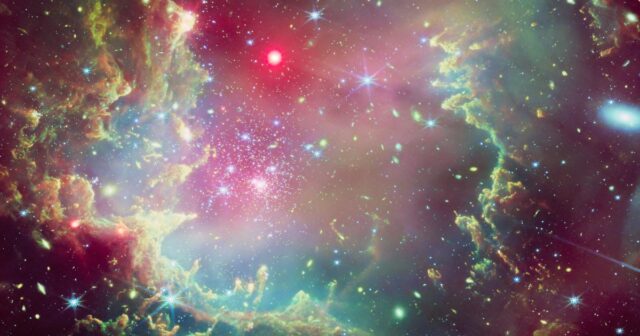NASA is ringing in the holiday season with the release of a new image, showing a cosmic wreath. The image, using data taken by several space telescopes, shows a star cluster called NGC 602, located in a nearby satellite galaxy of the Milky Way called the Small Magellanic Cloud.
The image combines data from the Chandra X-ray Observatory, which looks in the X-ray portion of the electromagnetic spectrum, and the James Webb Space Telescope, which looks in the infrared. The red points of glowing light are bright, massive, young stars that are giving off large amounts of radiation and were detected by Chandra, while Webb provided the background colors of orange, yellow, green, and blue that indicate the presence of the warm dust that forms the wreath shape.
Scientists are interested in studying the Small Magellanic Cloud because its stars have fewer heavy elements than the stars seen in galaxies like the Milky Way. Stars create heavy elements in their cores, then spread these elements into their surroundings when they explode as supernovas, so the presence of more heavy elements indicates an older galaxy. The Small Magellanic Cloud is similar to galaxies in the early universe, so studying it can give clues to how galaxies evolved over time.

In addition to the image of NGC 602, NASA also shared a jolly holiday-themed image of a cluster of stars called NGC 2264, or the “Christmas Tree Cluster.” The sparkles of red, purple, blue, and white are from Chandra data, while the green and violet background that makes up the Christmas tree shape is from optical data.
This cluster is located within our galaxy, and is just 2,500 light-years away, making it very close by cosmic standards. The cluster includes a variety of stars, some much larger and some smaller than our sun, ranging from just a tenth of the mass of the sun to over seven times its mass.
Please enable Javascript to view this content
As well as looking like pretty lights adorning the Christmas tree, the stars picked out by Chandra are young and volatile, giving off flares of energy including X-rays. They show variations in their outputs, due to factors like magnetic fields and flares, which makes them appear to twinkle.















































